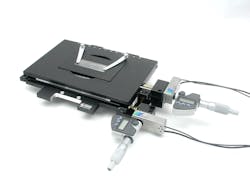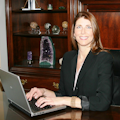PRODUCT FOCUS: NANOPOSITIONERS: Nanopositioning equipment answers the call from the world of the very small
Nanopositioning is the art of motion control on a very small scale at a very fast rate. Moving quickly from one tiny point to the next tiny point with exquisite accuracy is useful in a wide range of applications including super-resolution microscopy, metrology, nanolithography, interferometry, and imaging, among others. We spoke with several manufacturers of nanopositioning equipment to examine the available features and the latest products in the industry.
The term nanopositioner refers to a positioning device that provides repeatable, high-precision motion with increments of 1 nm or less over a range of several microns. Most commonly, nanometer-scale positioning is based on a piezoelectric ceramic stack that expands or contracts according to an applied voltage. Piezoelectric stacks limit the distance a positioner can travel, producing so-called "short travel" positioning on the order of hundreds of microns. Longer linear travel ranges are accomplished using levers, which can expand the travel distance to a few thousand microns. Nanometer-scale performance requires a frictionless drive, says Stefan Vorndran, vice president of marketing at Physik Instrumente (PI; Auburn, MA), so nanopositioning stages are usually flexure guided or driven by some type of solid-state actuator. "Some classical motorized positioners theoretically achieve nanometer resolution based on calculated resolution (motor steps, gearbox, screw pitch)," says Vorndran. "Because ‘nano' has become a buzzword in today's marketplace, many manufacturers now refer to these classical motor stages as nanopositioners. But we call these devices micropositioners, because due to friction in the drive system, they cannot provide repeatable, consecutive small steps at the nanometer level." The nanopositioning market is buzzing lately due to recent advances in super-high-resolution microscopy. Explains Jim Litynski, president at Piezosystem Jena's US division, (Hopedale, MA), "The big push right now is bio: cell biology and microscopy using super-high-resolution optical microscopes, such as the new structured illumination microscopes that have been out for about a year." Companies like Carl Zeiss MicroImaging GmbH (Jena, Germany) and Applied Precision (Seattle, WA) are ramping up installation of these microscopes, which project diffraction patterns onto cells, capture the images, and analyze them with increased resolution. The scopes require precision nanopositioning, and manufacturers are happy to comply (see Fig. 1).
These exacting requirements require precise guiding of the piezo actuators, which work by converting voltage into the force that drives the stage motion. Unfortunately, piezo actuators tend to twist and corkscrew, which can damage their fragile stacks. Flexure-guided stages are designed to restrict each axis of the stage to movement in only one direction, eliminating the unwanted motions in the actuator.1 "Piezo actuators also suffer from hysteresis (lagging) and creep, making them less than ideal for highly repeatable motion," says Jenice Con Foo, marketing manager at Mad City Labs (Madison, WI). "These drawbacks can be minimized by employing flexure-guided stages and the use of low-noise, high-stability position sensing. Flexure-guided stages produce highly parallel motion, which is crucial for nanopositioning."
Positioner components
In addition to an actuator and a guiding system, many nanopositioning applications require a "closed-loop" position sensor for feedback and control. "Direct metrology sensors in the form of capacitance sensors are a popular high-precision solution, providing unmatched long-term stability and linearity, completely free of Johnson noise," says PI's Vorndran. "However, they are more costly, and only a few companies have the expertise to manufacture them to the precision required for nanopositioning applications."
Another form of direct metrology sensor is Mad City Labs' proprietary PicoQ sensor, an innovative take on piezoresistive sensors that offers performance comparable to that of capacitive sensors. "The PicoQ provides direct position sensing with a noise floor in the picometer regime without the large 1/f noise that is characteristic of capacitive sensors2," says Con Foo (see Fig. 2).Last but not least is the command center of a positioning system, the controller, which can be digital or analog. Modern digital servo controllers can provide features such as advanced linearization, automatic triggers, complex motion contouring, autocalibration, and autotuning. According to Vorndran, lower-cost analog controllers are still widely used, but prices of digital servo controllers are coming down and may soon reach the analog level. As travel ranges increase, the latest generation of 24-bit nanopositioning controllers translates into command resolution on the order of 0.1 nm even on the longest-travel multiaxis piezo nanopositioning flexure stages (greater than 1.7 mm motion) currently available, provided that the noise level of the controller is not a limiting factor.
Manufacturers have several different categorization schemes, complicating the process of comparing different nanopositioners. According to Beda Espinoza, senior manager of product marketing at Newport Corp. (Irvine, CA), Newport categorizes nanopositioning products by function, such as push-pull actuators, movement along the linear x, x-y, or x-y-z axes, combined linear and tilt motions (θ-x/θ-y/z), focusing objectives, or micrometer adapters. Each of these types may involve either closed- or open-loop architectures.
According to Con Foo, Mad City Labs divides nanopositioning systems into three main categories: linear nanopositioning systems with up to 500 µm of motion per axis (x-y-z); rotational or tip/tilt stages with up to 10 mrad of motion per axis; and high-speed systems with scanning speeds in excess of 400 Hz. Within these categories there are many different designs suited to specific applications. Other manufacturers break it down by types of stage guiding, such as flexure-guided, piezowalk, and long travel.
Key specs
Numerous specifications for nanopositioning equipment depend entirely on your application. The trick is discerning which ones are pertinent to you. According to Espinoza at Newport, the specification process for most applications starts with desired travel range, followed by resolution (open- or closed-loop) and speed response. Litynski at Piezosystem Jena adds hysteresis (lagging of the stage) and drift as a top specification of concern for open-loop flexure-guided systems; they provide hysteresis curves for each stage they ship. Microscope focus drift, of particular concern in super-resolution microscopy applications, may be affected further by environmental conditions such as temperature change. If drift is a concern, look for a system designed to stabilize microscope focus.
Resolution, a very important specification, is often defined by the mechanical noise of the system. In open-loop systems, resolution is simply the noise of the power supply as it relates to the total travel of the stage. "For example," says Litynski, "if a stage is driven 100 µm using a voltage range from -20 to +130 V and the power supply has an rms noise of 200 µV, then we define the resolution of the system as 200 µV/150 V * 100 µm, or 1.3 × 10-10 m (0.1 nm). In closed-loop systems, this value is often higher because the feedback system may add noise to the electrical signal controlling the position of the stage."
Says Con Foo, "Our first priority is to consult with the user about their application, existing instrumentation, and the laboratory environment. It's important to understand the entirety of the application before prioritizing specifications and proposing a solution. The key specifications are usually stability and precision, which are closely tied to the overall noise performance. Noise performance data is more useful if presented as a noise power spectral density—noise as a function of frequency." (See http://bit.ly/bcQrCW.)
It pays to consult an experienced applications engineer. They should ask questions like: Is the application more static or dynamic? What minimum incremental motion (repeatable distance between smallest steps) is required? How important is long-term stability? What is the duty cycle? What lifetime is expected from the system?
Regarding system lifetime, a recent advance that has increased the lifetime of piezo drive elements is the encapsulation of the piezo stack in ceramic, says Vorndran. For even longer travel ranges, a new class of piezo motor device was recently developed: the linear piezowalk drive, which combines the travel range of classical motors with the precision of piezo-stack actuators. These linear motors consist of several individual piezo elements that generate motion through a succession of coordinated clamp/unclamp and expand/contract cycles (see http://bit.ly/9Tmmy0).
Also of concern, says Litynski: repeatability—a measure of how well the stage returns to the same location (dependent on noise in a closed-loop system); load capacity—how much mass the positioner can handle without damage; and settling time—typically defined as a 3 dB decay to a final position after implementation of a step function. Controller speed, throughput, flexible software architecture, and tight synchronization between command and execution are other specifications that may be important, depending on your application. Talking with more than one manufacturer may help you pin down the right positioner for your needs.
REFERENCES
Editor's note: The "Product Focus" series is intended to provide a broad overview of the product types discussed. Laser Focus World does not endorse or recommend any of the products mentioned in this article.
About the Author
Valerie Coffey-Rosich
Contributing Editor
Valerie Coffey-Rosich is a freelance science and technology writer and editor and a contributing editor for Laser Focus World; she previously served as an Associate Technical Editor (2000-2003) and a Senior Technical Editor (2007-2008) for Laser Focus World.
Valerie holds a BS in physics from the University of Nevada, Reno, and an MA in astronomy from Boston University. She specializes in editing and writing about optics, photonics, astronomy, and physics in academic, reference, and business-to-business publications. In addition to Laser Focus World, her work has appeared online and in print for clients such as the American Institute of Physics, American Heritage Dictionary, BioPhotonics, Encyclopedia Britannica, EuroPhotonics, the Optical Society of America, Photonics Focus, Photonics Spectra, Sky & Telescope, and many others. She is based in Palm Springs, California.



